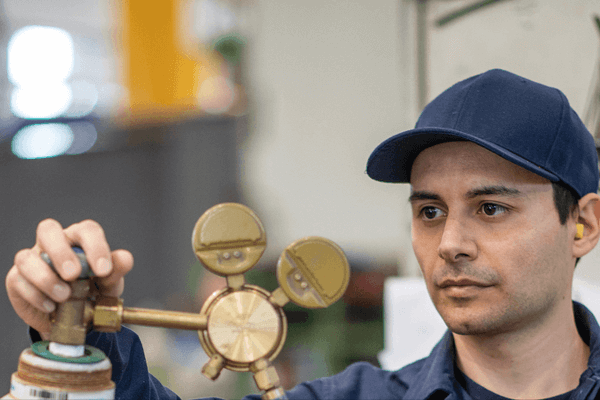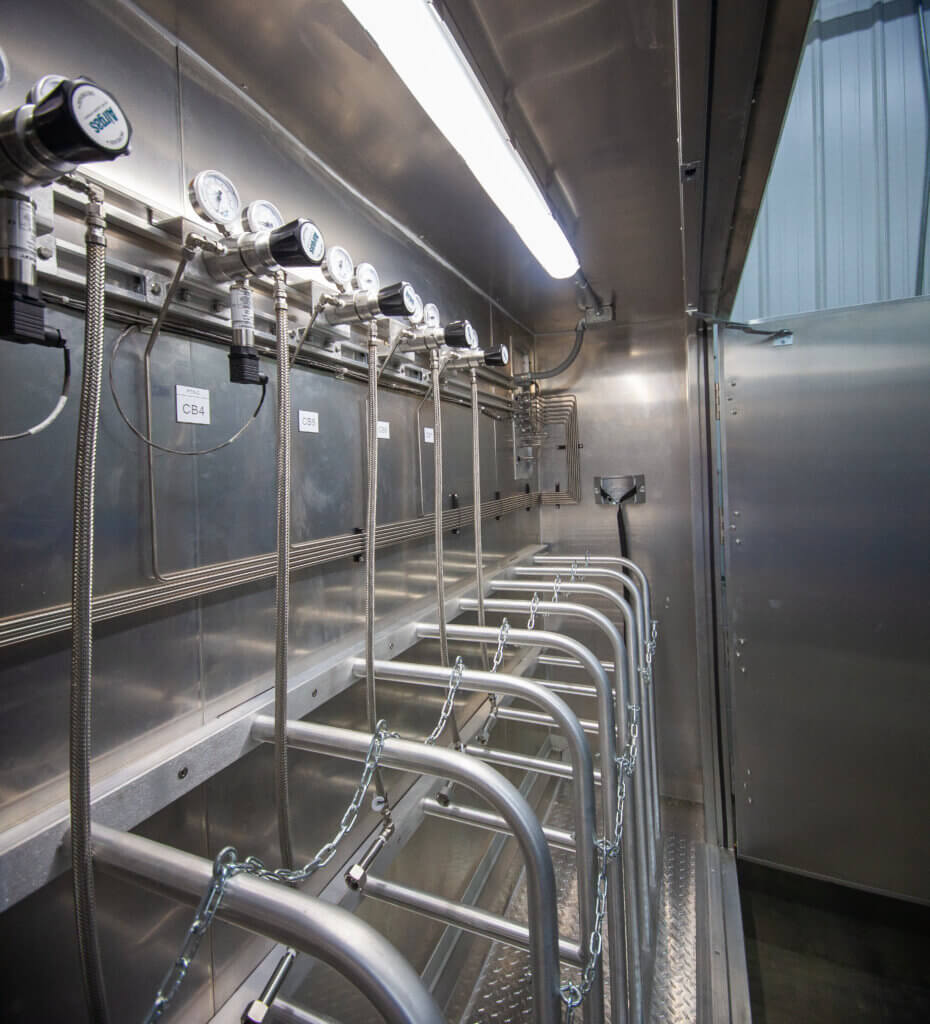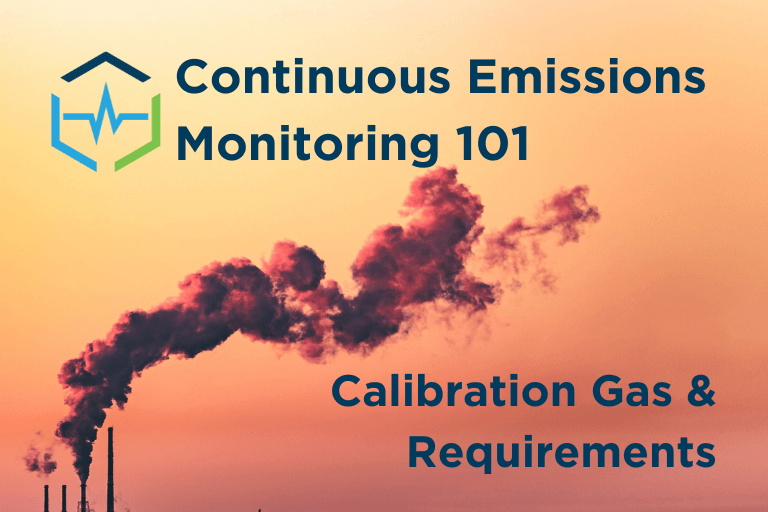Calibration Gas Requirements for CEMS Users
The concept of calibrating analyzers and other equipment seems simple enough. However, when we start talking about calibrating a CEMS, enough acronyms and percentages are thrown around to make things complex. This article will discuss and clarify the calibration requirements for a CEMS user.
System Calibration
When it comes to CEMS the first thing that must be discussed is exactly what is being calibrated. CEMS users know that the analyzers measuring the gases (like NOX, Oxygen, and CO) are where the adjustments are being made, but it’s important to recognize that the EPA regulations specify that the “entire” CEMS must be calibrated. This means that the cal gas is introduced as close as possible to where the sample gas enters the system, so that it can flow through the same path as the sample gas.
For a CEMS this means that the cal gas is sent up the umbilical and introduced at the front of the probe, where it then travels the same entire pathway as the stack gas, down to the analyzers. There are two different regs that apply to the majority of the CEMS in the US – Part 60 and Part 75. Although there are other specific state and local regs, this article will concentrate on these main two.
A. Daily Calibration Checks
The EPA Regulations state that a CEMS must be “checked’ every day. This is an automated process in a CEMS where a controller (PLC or datalogger) turns on and off solenoids to allow cal gas to enter the system. The DAS records the values and compares it to the known values to determine if the cal has passed or failed.
On a daily basis a zero and span check is done. The zero gas concentration used must be between 0-20% of the analyzer range that’s being checked. The span gas concentration must be between 50-100% for Part 60 systems, and 80-100% for Part 75 systems. So a typical span gas on a NOX analyzer ranged at 0-500 ppm would be somewhere between 250 ppm (50%) and 500 ppm (100%).

On a daily basis, a Part 60 CEMS must pass within 10% of the cal gas bottle concentrations. More than 10% error is considered a failed cal. There is also a “bad” cal designation, which is a cal error that is greater than 5%, but less than 10%. A CEMS is allowed 4 bad cals in a row, after which it’s considered a fail.
A Part 75 CEMS must pass within 5% error on a daily basis. In either system, if dual range analyzers are used, BOTH ranges must be checked. A failed cal typically requires operator intervention to adjust the analyzer.
B. Quarterly Calibration Audits
Per the EPA Regulations a CEMS user must perform quarterly calibration audits to show that their CEMS is performing properly. For simplicity this audit can be entirely automated and performed with a single push of a button. Again, a controller and solenoids work together to make this happen.
For Part 60 systems a Cylinder Gas Audit (or CGA) is performed. The CGA requires that the system is challenged three times each with low and mid level gases. The low level gas concentration must be within 20-30% of the analyzer range, and the mid must be between 50-60%. The error allowed for passing is 15%.
Part 75 system users must perform a Linearity test consisting of challenging the CEMS with 3 gas levels; low, mid & high. The low gas concentration must be between 20-30% of the analyzer range, mid: 50-60%, and hi: 80-100%. The error allowed for passing is 5%. To learn more about performing linearity checks, read our blog post.
Calibration Gas Bottles
Cal gas comes in a variety of configurations, blends and concentrations depending on the CEMS requirements. Typically CEM Systems use blended bottles to both save money and streamline the calibration time. Many gases can be blended together and remain stable.
A. Blends
A common blend example would be a NOX/CO/O2 CEMS where only two bottles would be needed for the daily zero and span of all three analyzers. The NOX and CO can be blended in a single bottle with nitrogen which allows for checking the span of the NOX and CO analyzer, and also checking the zero of the oxygen analyzer. A bottle with oxygen can check both the oxygen analyzer span and also act as a zero bottle for the NOX and CO analyzers.
B. Selecting a Grade
Cal gas manufacturers are under strict EPA control for the manufacturing of EPA Protocol bottles. To make EPA Protocol bottles a facility must be audited and have a registration number. There are NIST standards that must be adhered to and traceability protocols that must be followed. In an effort to differentiate themselves, cal gas manufacturers have introduced some confusion in the industry with regard to the different grades of gases by creating their own tradenames.
Part 60 and Part 75 regs both require the use of Protocol gas. The EPA regs state:
EPA Protocol gas concentrations must be certified by an EPA Protocol gas production site to have an analytical uncertainty (95-percent confidence interval) to be not more than plus or minus 2.0 percent (inclusive) of the certified concentration (tag value) of the gas mixture.
Manufacturers have created names like:
- EPA Protocol Gas
- EPA Certified Gas
- RATA Class Protocol Gas
- Compliance Class Protocol Gas
- Emission Credit Gas
- And more…
The bottom line is that CGA’s and Linearities for a CEMS must be performed with an EPA Protocol gas that is manufactured within ±2%. Many companies make 1% and 2 % Protocol Gases while some just sell the 1%. Either are acceptable.
In many faciltiies a NIST traceable Certified gas (1% or 2%) can be used for daily cals. Sometimes the price difference warrants the use of different grades – especially for the daily bottles which are used in greater quantities.
C. Bottle Life
Cal Gas bottles come with expiration dates on their certification certificates. Depending on the type of gas, these dates ranges from 1 to 8 years. Quarterly bottles tend to last for many years as they are only used 4 times a year. Typically they are certified for 2 years. The regs have been modified over the years and now allow for recertification of bottles to extend the usability range. It is often less expensive to send a bottle back to the manufacturer for recertification than purchasing a new bottle.
D. Bottle Placement
Cal gas bottles can be placed indoors or outdoors. Placing them close to the CEMS cabinet or shelter is best and placing on a ground floor is always better because of the routine replacement required.
When placed indoors, personnel protection must be taken into account in the event of a leak. Ambient gas monitors are most commonly used when bottles are placed inside a shelter. Outdoor placement requires the use of some type of hood or shelter to protect the regulators from freezing in the event of ice or snow buildup. The bottles themselves don’t need protection.
The cal gas bottles should be plumbed to the CEMS fittings via Teflon or stainless steel lines. Regulators are chosen based on the type of gas typically – corrosive or non-corrosive – and are made of brass or stainless.

How ESC Spectrum Can Help
Interested in learning a more comprehensive overview of how CEM Systems work? Read Understanding Continuous Emissions Monitoring Systems (CEMS): A Comprehensive Guide. This guide will give you a complete understanding of all the components in the flow of a CEMS.


